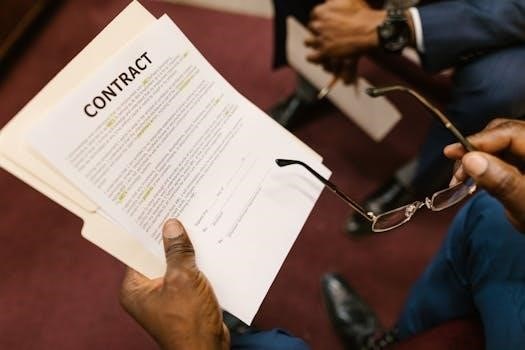Bank Account Closing Letter⁚ A Comprehensive Guide
This guide provides everything you need to know about crafting a formal bank account closing letter. From understanding the process to key elements and sample templates, we aim to simplify closing your account. Follow our comprehensive advice for the successful closure!
Understanding the Bank Account Closing Process
Closing a bank account involves several essential steps to ensure a smooth and secure transition. First, it’s crucial to verify that all outstanding transactions have cleared, including checks, payments, and automatic debits. Canceling any scheduled transactions is vital to prevent overdraft fees.
Next, gather all necessary account information, such as account numbers and personal identification. Contact your bank to inquire about their specific closing procedures. Some banks require a written request, while others may allow in-person or online closures.
Prepare your closing letter, detailing your account information, desired closure date, and instructions for the remaining balance. Submit your letter through the bank’s preferred method, such as mail or in-person delivery. Following up with the bank confirms the closure and ensures proper handling of your funds.
Finally, retain copies of all communication for your records.
Why Write a Bank Account Closing Letter?
A bank account closing letter serves as a formal, written record of your request to close an account. It provides clear instructions to the bank, minimizing potential misunderstandings or errors. This letter ensures that your intentions are documented, protecting you from future liabilities associated with the account.
It allows you to specify the exact date you want the account closed and how you want any remaining funds handled, whether by check, transfer, or another method. Providing these instructions in writing ensures that the bank follows your wishes accurately.

The letter can also serve as proof that you initiated the closure, which can be valuable if disputes arise later. In some cases, banks require a written request for closure, making the letter a necessary step. By sending a closing letter, you maintain control over the process and create a clear audit trail.
Ultimately, it is a proactive measure that protects your interests.
Key Elements of a Bank Account Closing Letter
A well-crafted bank account closing letter should include several key elements to ensure clarity and accuracy. Start with the account holder’s information, including your full name, current address, and phone number. This helps the bank easily identify you and your account.
Clearly state the account number(s) to be closed. List each account number you wish to terminate to avoid any confusion. Provide the effective date of closure, specifying when you want the account to be officially closed. This ensures the bank processes your request at the right time.
Include instructions for the remaining balance. Indicate how you want the bank to handle any funds left in the account, such as transferring them to another account or sending a check to your address.
Finally, add your signature and contact information. Sign the letter and provide an email address or phone number for the bank to contact you with any questions. Including these elements ensures a smooth and efficient account closure process.
Account Holder Information
The initial section of your bank account closing letter must clearly present your personal details as the account holder. Begin by stating your full legal name, as it appears on the bank account records. This ensures accurate identification and avoids any potential processing delays.
Next, provide your current mailing address. This is crucial for the bank to send any final statements, checks for the remaining balance, or important correspondence related to the account closure. Make sure the address is up-to-date to prevent misdirected mail.
Include your phone number and email address. Providing multiple contact methods allows the bank to reach you quickly if they have any questions or need additional information. This can expedite the closing process and resolve any issues efficiently.
Accuracy in this section is paramount. Double-check all the information to ensure it matches the bank’s records. Any discrepancies could lead to delays or complications in closing your account.
Account Number(s) to be Closed
Clearly state the full account number(s) you wish to close. Accuracy is paramount here; double-check each digit against your bank statements or online banking portal. If you have multiple accounts at the same bank, list each one separately to avoid confusion.
Specify the type of each account (e.g., checking, savings, money market). This helps the bank correctly identify and process your request. For joint accounts, include all account holder names and indicate if all parties agree to the closure.
If you’re closing multiple accounts, consider using a numbered list for clarity. This makes it easy for the bank to verify the information and ensures that all specified accounts are closed as intended.
Avoid ambiguity by using precise language. For example, instead of saying “my savings account,” provide the full account number and type. This eliminates any potential for error and streamlines the account closure process.
Effective Date of Closure
Clearly specify when you want the account to be closed. This is a crucial detail, as it dictates when the bank should cease all activity on the account. You can request immediate closure or specify a future date, depending on your needs.
If you choose a future date, ensure it allows sufficient time for any outstanding transactions to clear. This prevents complications such as returned payments or overdraft fees. Consider potential delays, especially if you have recurring payments or automatic transfers linked to the account.
If you need the account closed immediately, state this explicitly in your letter. However, be aware that immediate closure might not be possible if there are pending transactions. Check your account balance and recent activity before requesting immediate closure.
The bank will likely use the effective date to finalize the account closure process. This includes stopping interest accrual and sending any remaining balance as per your instructions; Provide a specific date rather than vague terms like “as soon as possible.”
Instructions for Remaining Balance
Your closing letter should clearly state how you want the remaining balance handled. Banks typically offer several options⁚ a check mailed to your address, a transfer to another account, or a withdrawal in person. Specify your preferred method to avoid delays or misunderstandings.
If you choose a check, confirm the mailing address in your letter. If it differs from the address on file, provide the updated address for accurate delivery. For transfers, provide the complete account details of the receiving account, including the bank name, account number, and routing number;
Consider any fees associated with each option. Some banks may charge a fee for mailing a check or initiating a wire transfer. Ask the bank about these fees beforehand to make an informed decision.
If you opt for an in-person withdrawal, indicate when you plan to visit the bank. This allows the bank to prepare the funds and expedite the process. Remember to bring valid identification for verification purposes.
By providing clear and concise instructions, you ensure the bank handles your remaining balance according to your wishes, leading to a smooth account closure.
Signature and Contact Information
Your signature is essential, validating the letter as an official request. Sign your name as it appears on the account records. Illegible signatures can cause delays, so sign clearly. If you have a joint account, check if both signatures are required.
Include your current phone number and email address. This allows the bank to contact you if they need clarification or have questions about your request. Provide the best number to reach you during business hours for a prompt resolution.
Ensure your contact information is accurate. Outdated contact information can hinder communication and delay the closing process. Double-check all details before sending the letter.
Consider adding an alternative contact method, such as a secondary phone number or email address. This provides the bank with additional ways to reach you if needed.
By providing a clear signature and up-to-date contact information, you facilitate efficient communication with the bank, ensuring a seamless and timely account closure. This minimizes potential issues and helps expedite the process.
Sample Bank Account Closing Letter Template
Using a template ensures your letter includes all necessary information. A typical template starts with your name, address, and the date, followed by the bank’s address. The subject line should clearly state “Account Closure Request.”
The body of the letter should include the account number(s) you wish to close and the effective date of closure. Specify how you want the remaining balance handled – whether by check, transfer to another account, or direct deposit.
The template should also include a section for your signature and contact information. Ensure you provide a current phone number and email address for any follow-up communication.
Many templates are available online, offering a structured format. Adapt the template to your specific needs, ensuring all details are accurate and complete. A well-structured template saves time and minimizes errors.
By using a sample template, you can create a professional and comprehensive closing letter, reducing the risk of delays or misunderstandings with the bank. Always review the completed letter before sending.
Formatting Your Bank Account Closing Letter
Proper formatting ensures your letter is professional and easy to read. Use a standard business letter format with a clear, concise layout. Begin with your address and the date at the top, followed by the bank’s address. Use a professional font like Times New Roman or Arial in size 12.
Maintain single spacing within paragraphs and double spacing between paragraphs. Keep the margins at one inch on all sides to provide a clean, uncluttered appearance. Left-align the text for readability. The subject line should be bold and clear, such as “Account Closure Request ⎯ [Your Name].”
In the body of the letter, use short, direct sentences. Avoid jargon or overly complex language. Use bullet points or numbered lists to itemize account numbers or instructions for the remaining balance.
The closing should be professional, such as “Sincerely” or “Respectfully,” followed by your signature and typed name. Ensure your contact information, including phone number and email, is clearly visible.
A well-formatted letter demonstrates attention to detail and professionalism, facilitating a smoother account closure process. Always proofread the letter for errors before sending it to the bank.
Delivery Methods for Your Closing Letter
Choosing the right delivery method for your bank account closing letter is crucial for ensuring it reaches the bank promptly and securely. Several options are available, each with its own advantages.
Certified mail with return receipt requested is a reliable method. It provides proof that the bank received your letter, which can be useful if any issues arise during the closure process. This method ensures a verifiable record of delivery.

Another option is to deliver the letter in person to a bank representative. Obtain a signed and dated receipt as proof of delivery. This method allows for immediate confirmation and can expedite the process.
Some banks may accept closing letters via email, especially if a secure email system is in place. Confirm with the bank whether this method is acceptable and follow their specific instructions for submitting the letter electronically.
Faxing the letter is another alternative, though less secure than certified mail or in-person delivery. If faxing, ensure you receive a confirmation that the fax was successfully sent.
Consider the urgency and your need for proof of delivery when selecting a method. Certified mail or in-person delivery is generally recommended for important documents like bank account closure requests.
Following Up with the Bank

After sending your bank account closing letter, it’s essential to follow up to ensure your request is processed efficiently and correctly. A timely follow-up can prevent potential delays or misunderstandings.
Wait a reasonable period, typically 5-7 business days, before contacting the bank. This allows sufficient time for your letter to be received and for the closure process to begin. If you haven’t heard back, it’s time to take action.
When you contact the bank, reference the date you sent the closing letter and the account number you requested to be closed. This helps the bank locate your request quickly. You can call the bank’s customer service line or visit a branch in person.
Inquire about the status of your account closure and confirm the date it will be finalized. Also, verify how any remaining balance will be handled, whether by check, electronic transfer, or another method. Make sure you agree with the process.
Keep a record of all communication with the bank, including dates, times, and the names of representatives you spoke with. This documentation can be valuable if any discrepancies arise later.
If you encounter any issues or delays, remain persistent but polite in your follow-up efforts. Clear and consistent communication is key to resolving any problems and ensuring a smooth account closure.
Alternatives to a Formal Letter

While a formal bank account closing letter is often recommended, several alternatives can be used depending on the bank’s policies and your preferences. Exploring these options can sometimes simplify the closure process.
One common alternative is visiting a local branch in person. This allows you to speak directly with a bank representative, complete the necessary paperwork on the spot, and receive immediate confirmation of your account closure. This option can be particularly useful if you have a more complex situation or prefer face-to-face interaction.
Many banks also offer online account closure options through their website or mobile app. This typically involves logging into your account, navigating to the account services section, and following the prompts to close your account electronically. This method is convenient and can be completed at any time.
Another possibility is contacting the bank’s customer service via phone. A representative can guide you through the closure process and may be able to complete the request over the phone. Be prepared to provide identifying information to verify your identity.
Before choosing an alternative, check with your bank to understand their specific procedures and requirements for closing an account. Some banks may still require a written request in certain situations.
Regardless of the method you choose, always obtain written confirmation of the account closure, whether it’s a receipt from a branch visit, an email confirmation, or a reference number from a phone call. This confirmation serves as proof that your account has been closed and can be helpful if any issues arise in the future.
Checking Account Closure Considerations
Closing a checking account requires careful planning to avoid potential complications. Several factors should be considered before initiating the closure process, ensuring a smooth transition and preventing disruptions to your finances.
Firstly, ensure that all outstanding transactions have cleared. This includes checks you’ve written, automatic payments, and any pending withdrawals. Waiting until all transactions are processed prevents overdraft fees or returned payments, which can complicate the closure.
Review your automatic payments and direct deposits. Update these with your new account information to avoid missed payments or interruptions in receiving funds. This is crucial for recurring bills, subscriptions, and payroll deposits.
Consider the timing of your closure. Avoid closing your account right before important payments or deposits are due. Give yourself ample time to transfer funds and update your payment information.
If you have a debit card associated with the account, destroy it after the account is closed to prevent unauthorized use. Contact the bank to confirm the card is deactivated.
Request a final statement from the bank to verify that all transactions have been processed and the account balance is zero. This statement serves as a record of your account activity and can be useful for future reference.
Finally, be aware of any potential fees associated with closing the account. Some banks may charge a fee for early closure or for transferring the remaining balance. Check with your bank to understand their fee structure.
Savings Account Closure Considerations
Closing a savings account, while seemingly straightforward, involves several important considerations to ensure a seamless process. Proper planning can prevent unexpected issues and help you manage your finances effectively.
Firstly, assess your financial goals and ensure that closing the savings account aligns with your overall strategy. Consider whether you need the funds for immediate use or if alternative savings options are more suitable.
Review the interest earned on your savings account. Some banks may have specific rules about when interest is credited, and closing the account before the interest is paid out could result in losing those earnings. Check your account statement for details.
Determine the best method for transferring the remaining balance. You can request a check, transfer the funds to another account, or withdraw the cash in person. Choose the option that best suits your needs and convenience.
Be mindful of any penalties or fees associated with closing the account. Some banks may charge a fee for early closure or for transferring large sums of money. Inquire about these fees beforehand to avoid surprises.
If the savings account is linked to other accounts, such as a checking account or a loan, ensure that you update the necessary information to avoid disruptions in your banking services. This is especially important for overdraft protection or automatic transfers.
Keep a record of the account closure and any related transactions. This documentation can be useful for tax purposes and for resolving any potential discrepancies in the future.
Finally, consider the emotional aspect of closing a savings account. If the account holds sentimental value or represents a significant financial milestone, take a moment to reflect on its purpose and the progress you’ve made.